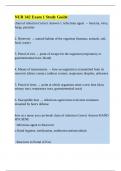NUR 342 Exam 1 Study Guide
chain of infection Correct Answer-1. Infectious agent → bacteria, virus,
fungi, parasites
2. Reservoir → natural habitat of the organism (humans, animals, soil,
food, water)
3. Portal of exit → point of escape for the organism (respiratory or
gastrointestinal tract, blood)
4. Means of transmission → how an organism is transmitted from its
reservoir (direct contact, indirect contact, respiratory droplets, airborne)
5. Portal of entry → point at which organisms enter a new host (skin,
urinary tract, respiratory tract, gastrointestinal tract)
6. Susceptible host → infectious agent must overcome resistance
mounted by host's defense
how as a nurse you can break chain of infection Correct Answer-HAND
HYGIENE
· Infectious agent to Reservoir
o Hand hygiene, sterilization, antibiotics/antimicrobials
· Reservoir to Portal of Exit
,o Transmission-based precautions, sterilization or use of disposable
supplies
· Portal of Exit to Mode of Transmission
o Dry intact dressing, hand hygiene, wear gloves if contact with body
fluids, cover nose and mouth when sneezing
· Mode of Transmission to Portals of Entry
o Hand hygiene, use of pesticides to eliminate vectors, adequate
refrigeration
· Portals of Entry to Susceptible Host
o Hand hygiene, wear gloves, use masks and appropriate protective gear,
proper disposal of needles/sharps
· Susceptible Host to Infectious Agent
o Immunizations, screen health care staff
risk factors for infection: Correct Answer-· Integrity of skin and mucous
membranes
· pH levels of GI and GU tracts
· Integrity and number of body's WBC
· Age (infants and elderly)
· Immunizations
,· Level of fatigue, nutrition and general health status (including pre-
existing conditions)
· Stress level
·Use of invasive or indwelling medical devices
· Lack of immunizations, natural or acquired
methods of infection transmission Correct Answer-· Direct Contact
Infections spread by contact, such as touching, kissing, or sexual
intercourse
MRSA
· Indirect Contact
Infections spread by no direct human-to-human contact
Contaminated surfaces or objects (fomite)
Tick, rodent (vector)
· Respiratory droplets
Infections spread by large-particle droplets
Influenzas, mumps, diphtheria, and rubella
· Airborne
Infections spread through the air
Tuberculosis, varicella, rubeola, COVID
, Differences between medical and surgical asepsis Correct Answer-
Medical asepsis → a.k.a "clean technique," practices that assist in
reducing the risk of infection
· Goal → PREVENT SPREAD of microorganisms
VS.
Surgical asepsis → a.k.a "sterile technique," practices to render and keep
objects free from microorganisms; more stringent
· Goal → DESTROYS ALL microorganisms, including spores
principals surgical asepsis (objects touching each other, when is it
consider contaminated, what do you do, what's no sterile in a field.
Correct Answer-9 Principals of Surgical Asepsis
1. A sterile object remains sterile only when touched by another sterile
object
2. Only sterile objects may be placed on a sterile field. All items on a
sterile field must be sterile
3. A sterile object or field out of the range of vision is considered
contaminated
4. A sterile object or field becomes contaminated by prolonged exposure
to air
5. When a sterile surface comes in contact with a wet, contaminated
surface, the sterile object or field becomes contaminated by capillary
action




